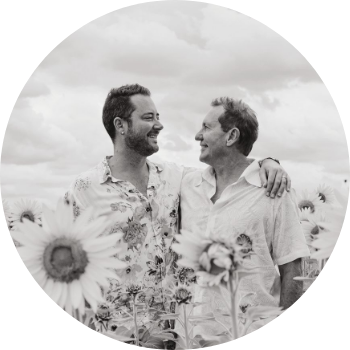
SMILE DARLING
SMILE DARLING
ON
BOARD
WITH
Malcolm Watkins
and Pete Kerr
The Australian couple on the joy of yachting Down Under on board Askari
After years cruising the Med, Pete Kerr and Malcolm Watkins went home with a new boat. They tell Sam Fortescue about the joy of sailing Askari
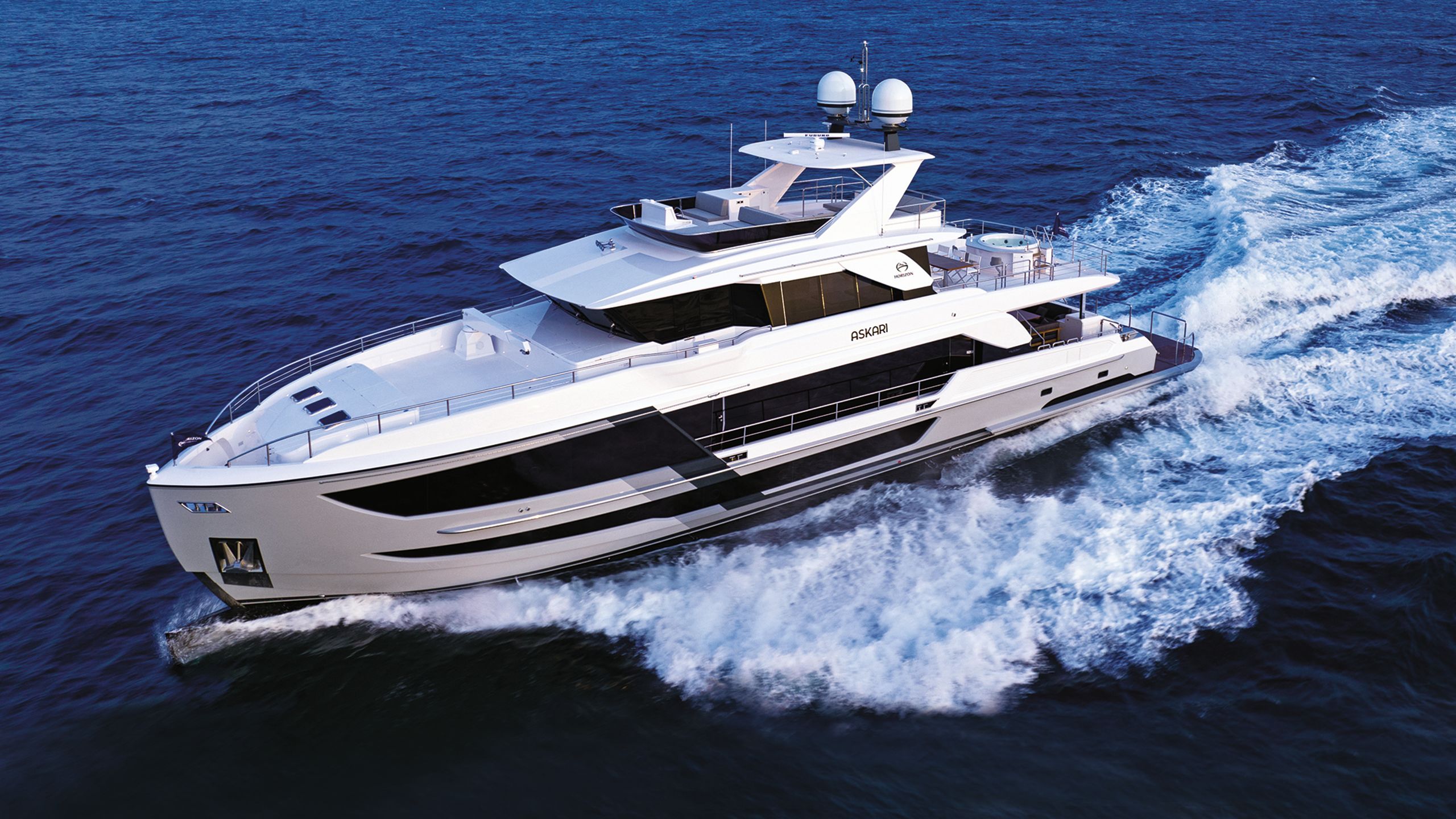
Dressed in Hawaiian print shirts and shorts, the tropical sun glittering on the water behind them, it is fair to say that Pete Kerr and Malcolm Watkins are “over” Europe. This Australian yachting couple had been getting their kicks in the Med for years, sailing the storied Perini Navi sloop Elettra between the region’s yachting hotspots. But enough was enough. They sold her, returned to local waters and commissioned a new 31-metre yacht from Taiwan.
“We were doing month on, month off over the European summer, three months a year,” says Kerr. Watkins sighs. “You miss out on a lot of social events in Australia – weddings, birthdays, friend get-togethers,” he explains. “So, after six or seven years sailing in the Mediterranean, we said ‘We’ve done it, so let’s go home for a while.’”
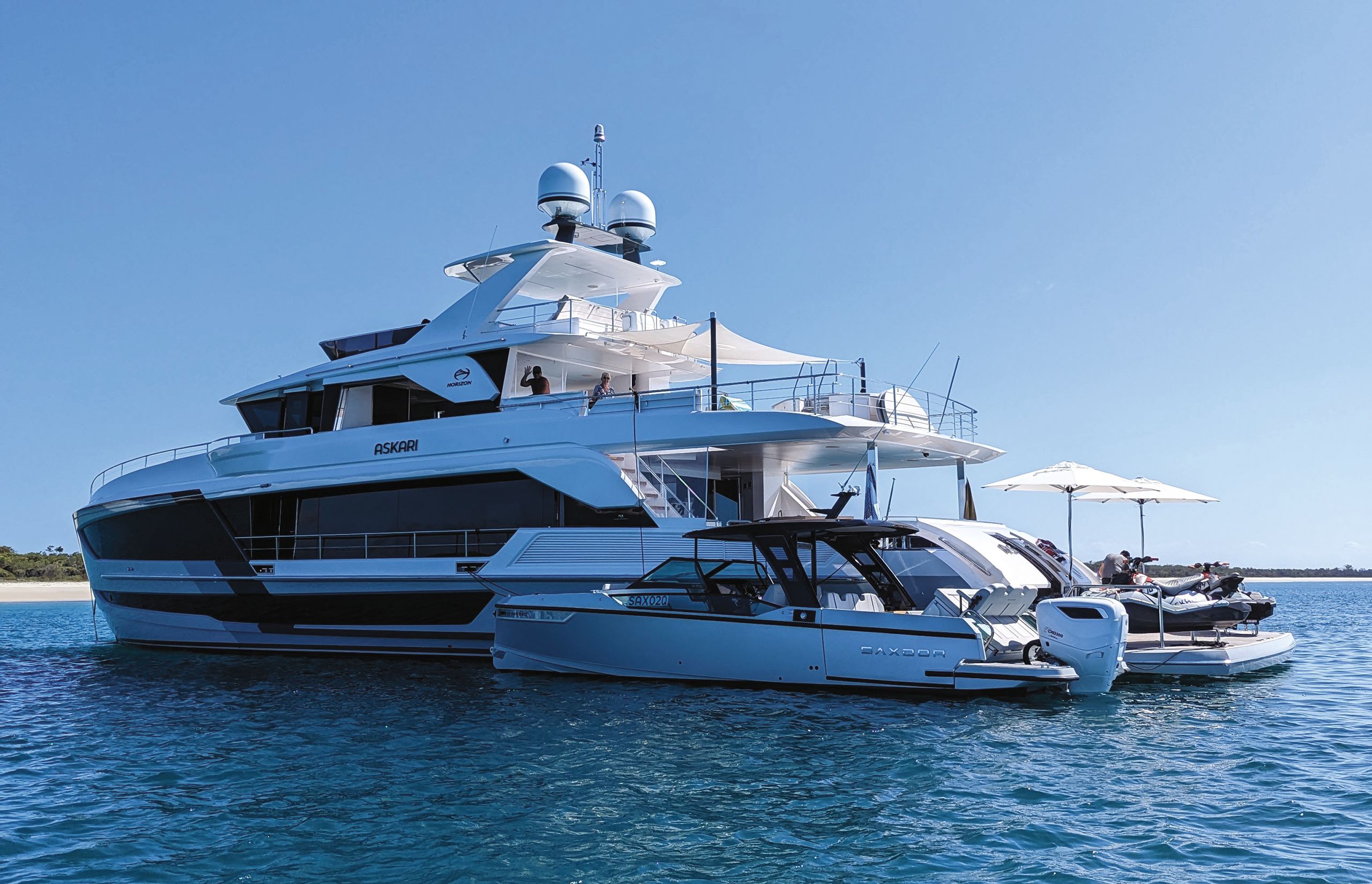
Beautiful, woody Elettra went up for sale and, with her previous connection to yard owner Fabio Perini, for whom she was built, she was quickly snapped up. Changing boating hemispheres, shifting from sail to motor: as in many cases, it turns out there was a new arrival at the root of the couple’s decision. A miniature schnauzer, in fact. “When we decided we wanted a dog, changing to a motor yacht just made sense,” says Kerr.
Watkins elaborates with an air of mischief. “Yachts and dogs don’t really like the heeling-over business, so we had to switch. And Pete liked the move, because he didn’t keep spilling his drink!”
The son of a soldier and biologist, Malcolm Watkins spent his early years in Kenya, where he was introduced to sailing at the tender age of four in a homemade dinghy. The family returned to Perth, where he switched to Hobie Cats, but also began to enjoy the speed of motorboats. In a 5.7-meter, then a Jenks 25, he’d finish classes then head to the nearby island of Rottnest, or “Rotto” as the locals call it. “You’d shoot across there, stick it in the beach, go surfing and overnight comfortably – all in the space of 24 hours. You just can’t do that in sailing yachts.”
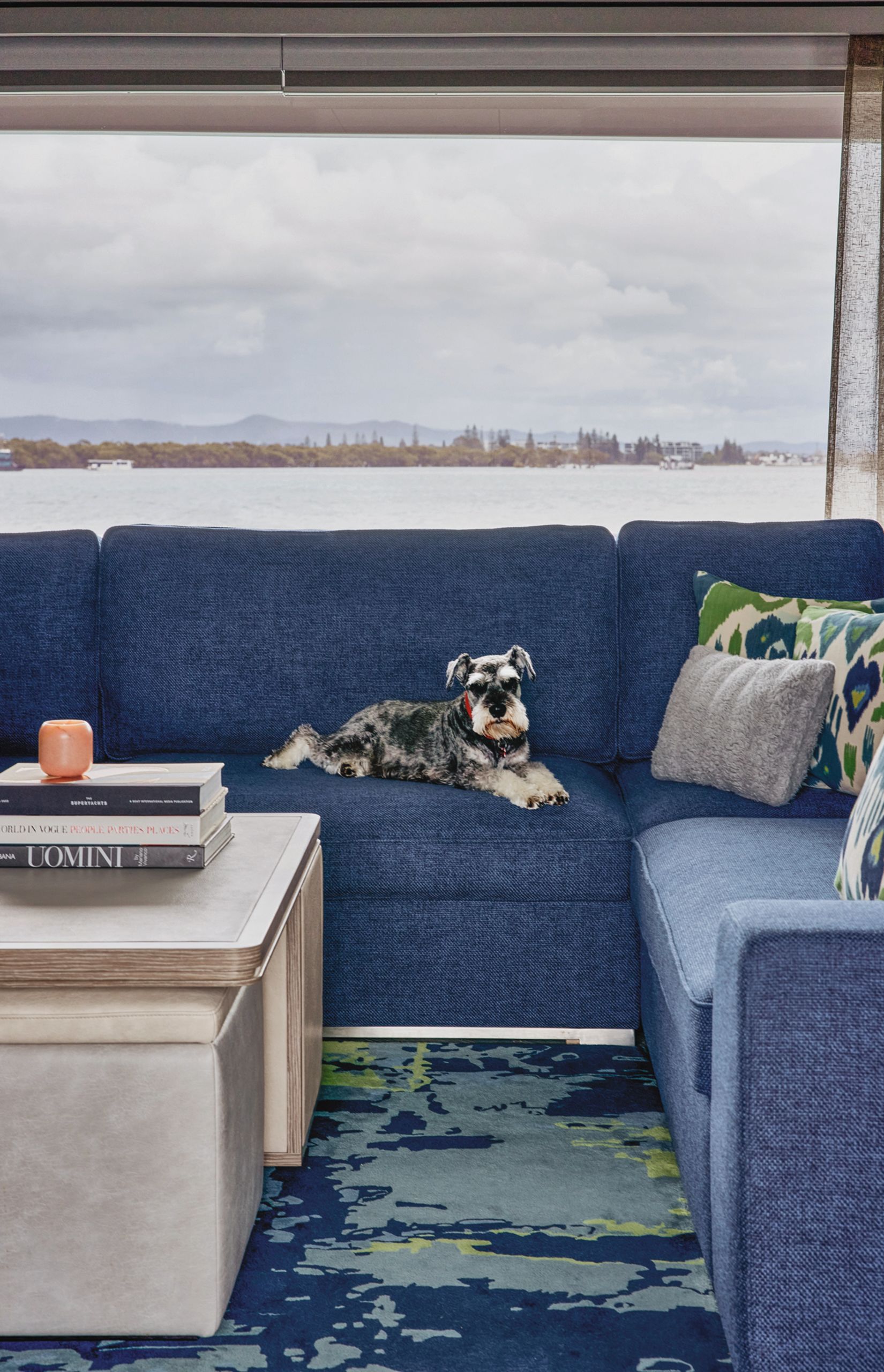
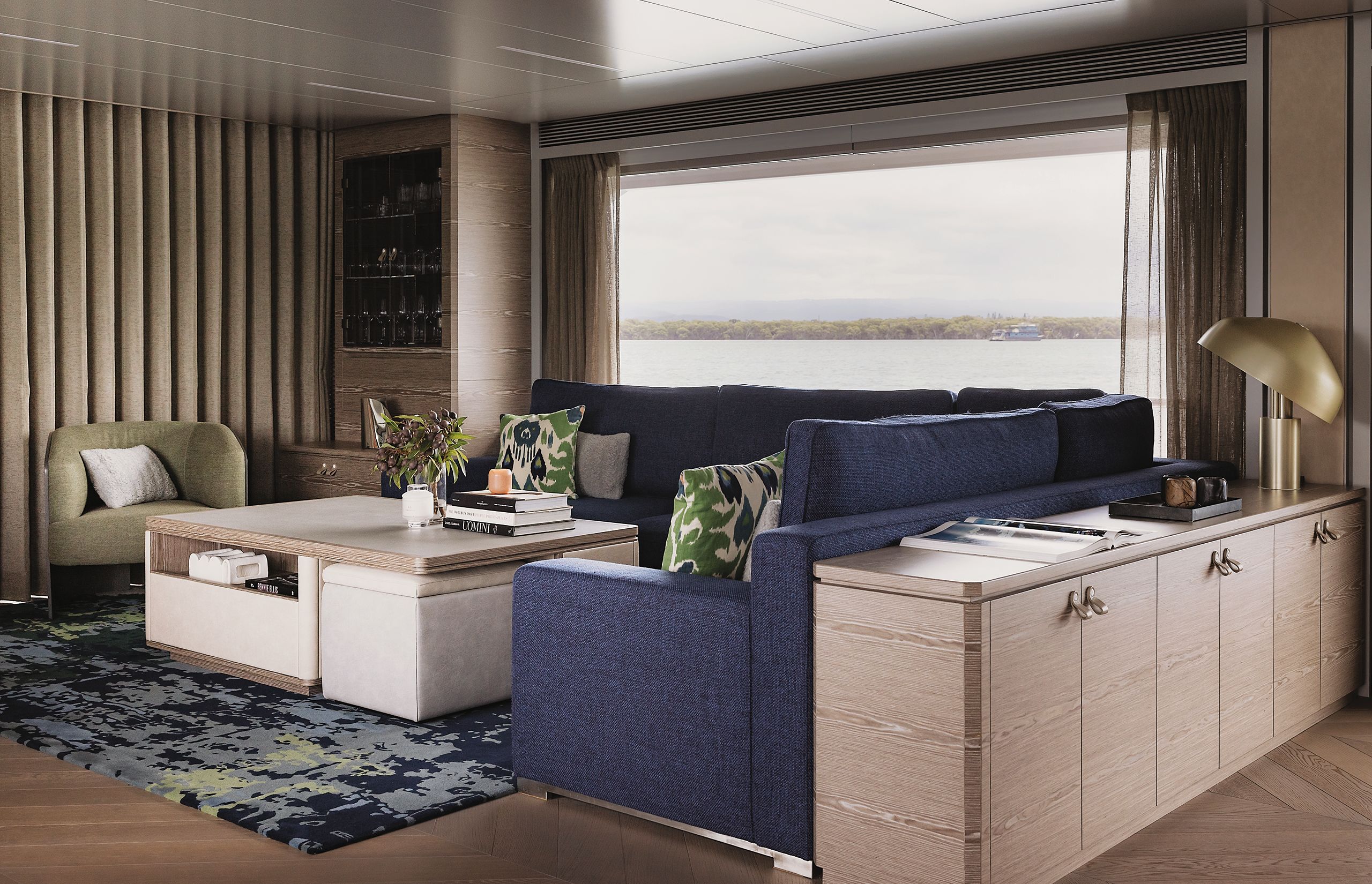
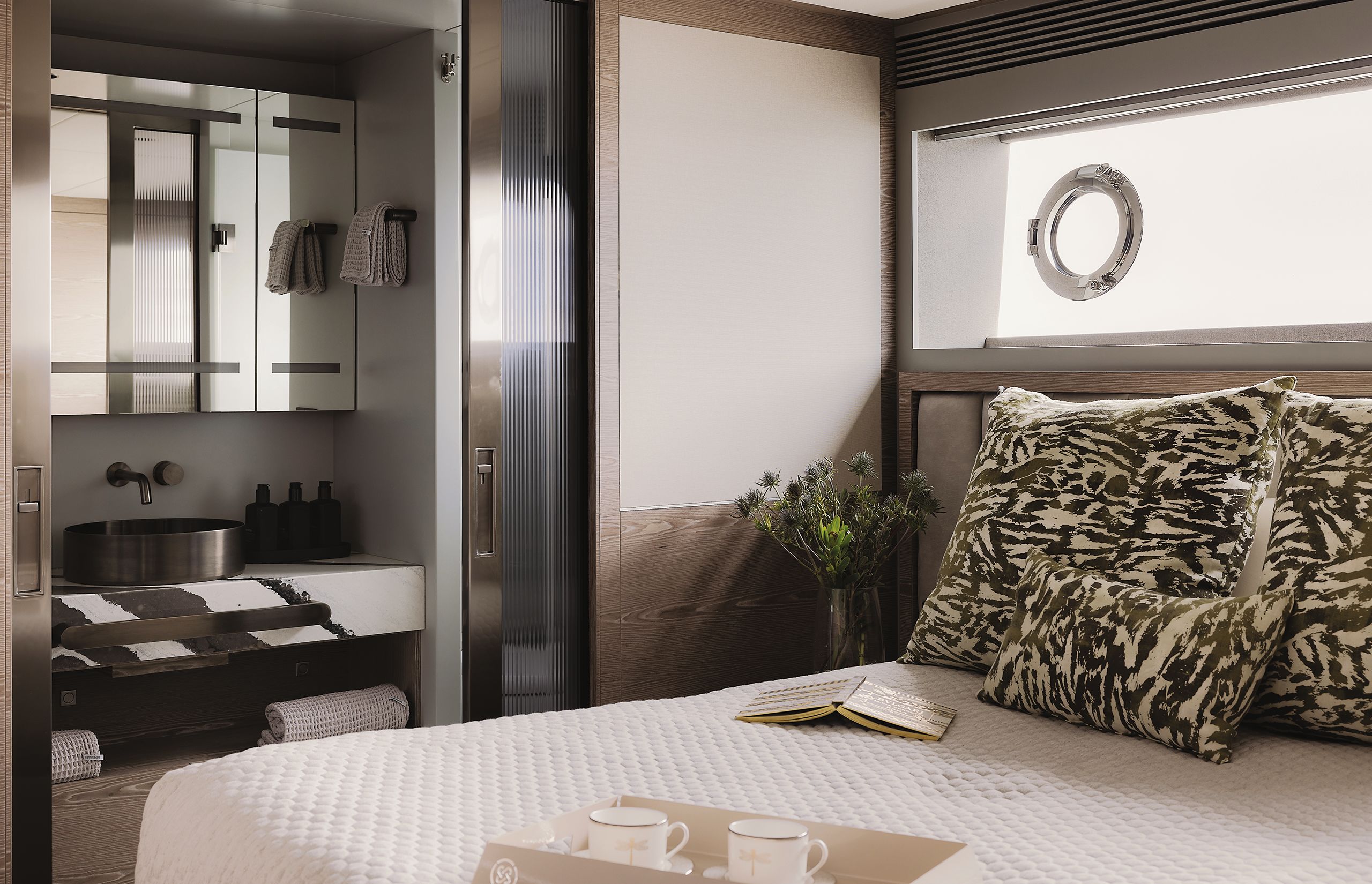
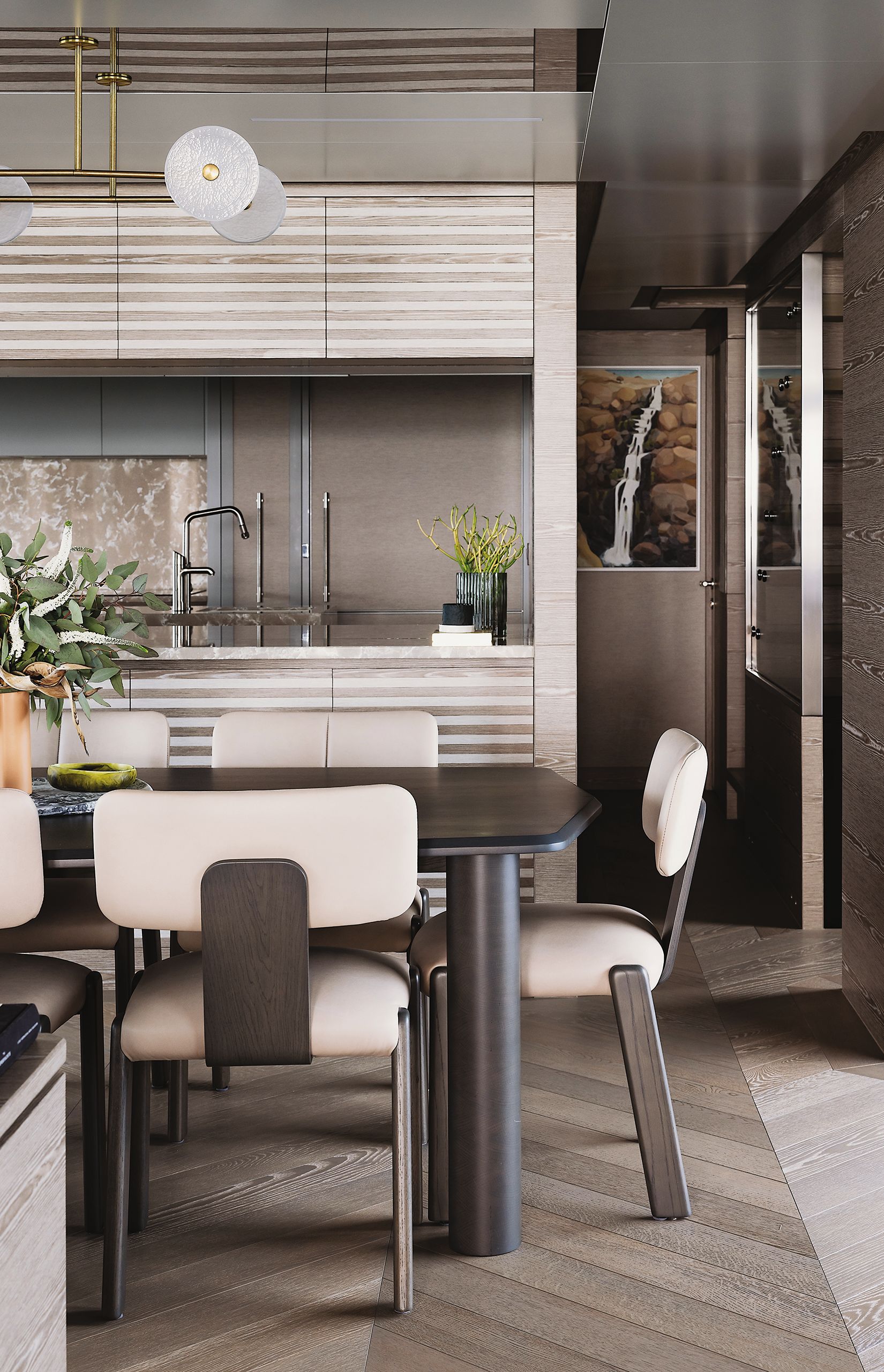

BROCK BEAZLEY
BROCK BEAZLEY

BROCK BEAZLEY
BROCK BEAZLEY

BROCK BEAZLEY
BROCK BEAZLEY

BROCK BEAZLEY
BROCK BEAZLEY
A graduate of Sydney Design School, Pete Kerr undertook interior design duties himself, opting for a palette of dark blues for the furniture so as not to detract the eye from the surrounding scenery… and remain dog-friendly
Since then, there’s also been a second-hand Princess 60 flybridge in Perth and a Princess 61 based out of Melbourne, for getting afloat at home when the Mediterranean was in the grip of winter. “Probably the first large motor boat I’d ever been on,” says Kerr, who grew up in Melbourne, London and Auckland and initially followed a career in global drinks logistics.
But there was a problem. “In Oz, there are longer distances between ports and cafés, so you need more on-deck space, a much larger galley and more expansive facilities,” explains Watkins.
“We wanted an entertainer’s kitchen rather than a galley – a country kitchen. And because we didn’t run crew, we didn’t want a boat where one of us was left cooking downstairs in a hole.”
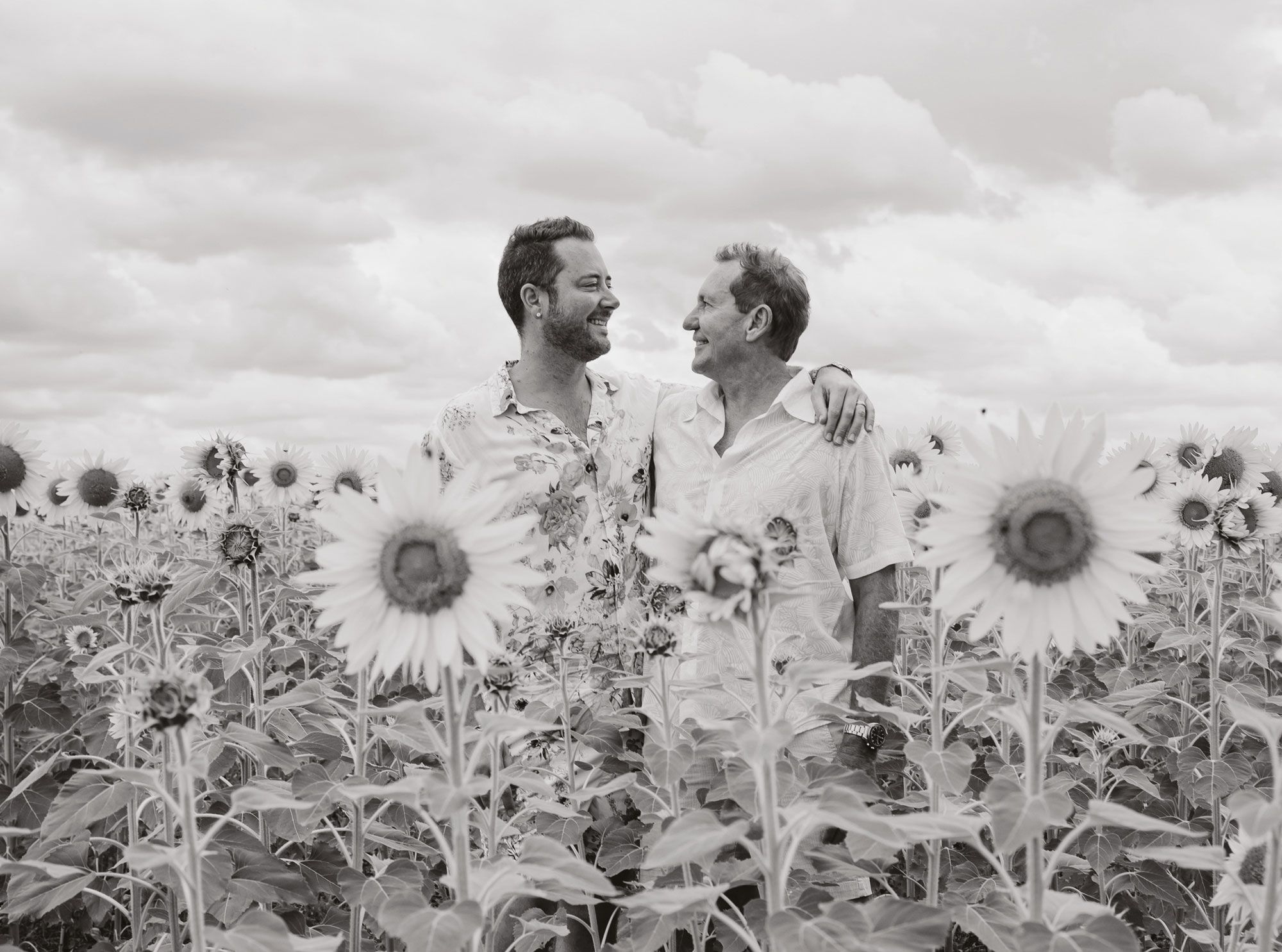
In other words, the Princess simply wasn’t big enough anymore. And since they couldn’t find anything that answered among the primarily European designs available in Australia, they turned their gaze to the US. The couple soon found themselves at the Fort Lauderdale International Boat Show, where they were due to inspect a 24-metre Ocean Alexander. The day before, however, their broker took them to see a pretty 23.7-metre OA and they fell in love with its solid construction, expansive on-deck entertainer’s galley and generous living spaces.
L/V III served them well in Australia, and by a stroke of good fortune, the couple were aboard when the Covid-19 shutters came crashing down on 20 March 2020. “People were only allowed to walk in single file, nothing after dark,” says Watkins. “Melbourne was the most locked-down city in the world. We simply couldn’t get back in.”
“When we packed our bags, we thought we were going for few weeks, then they shut the border and that was is it,” Kerr chips in. “We were gone for three months.”
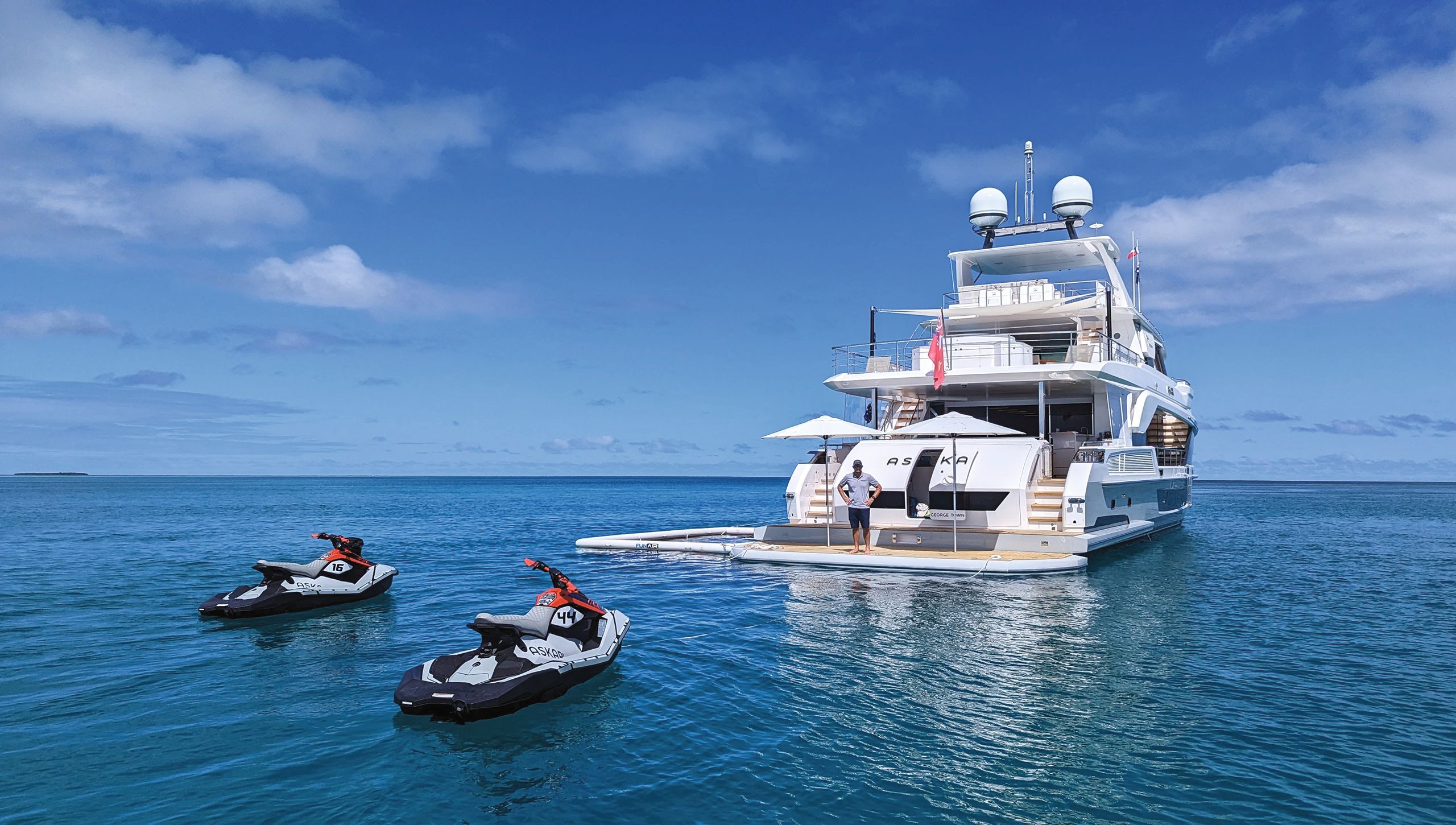
“We didn’t leave Australian waters, but we cruised up to North Queensland,” continues Watkins. “It was like a different planet there. Once they’d shut the borders, it was as if Covid didn’t exist. While Boris Johnson was getting into trouble for tea parties, we were going to 500-people beach parties with DJs. We were on ‘Fugitive Jetty’ – it was always happy hour!”
Living the dream it may have been, but it seems unlikely that it was quite as carefree as Watkins suggests. After all, he was still running AFG, the home financing business that he had built from scratch with three friends from university. Now employing more than 200 people, and working with 4,000 brokers, 80 lenders, one in 10 Australian home loans goes through their books. It’s close to becoming a billion-dollar business.
AFG nearly didn’t happen at all, as Watkins trained to be a dentist. “But I decided I didn’t like looking down people’s mouths,” he says. “So me and a friend deferred all that and went travelling around the world. Both of us decided we liked sales, but when I got back I had to work for a year clearing farmland to pay off my debt.”
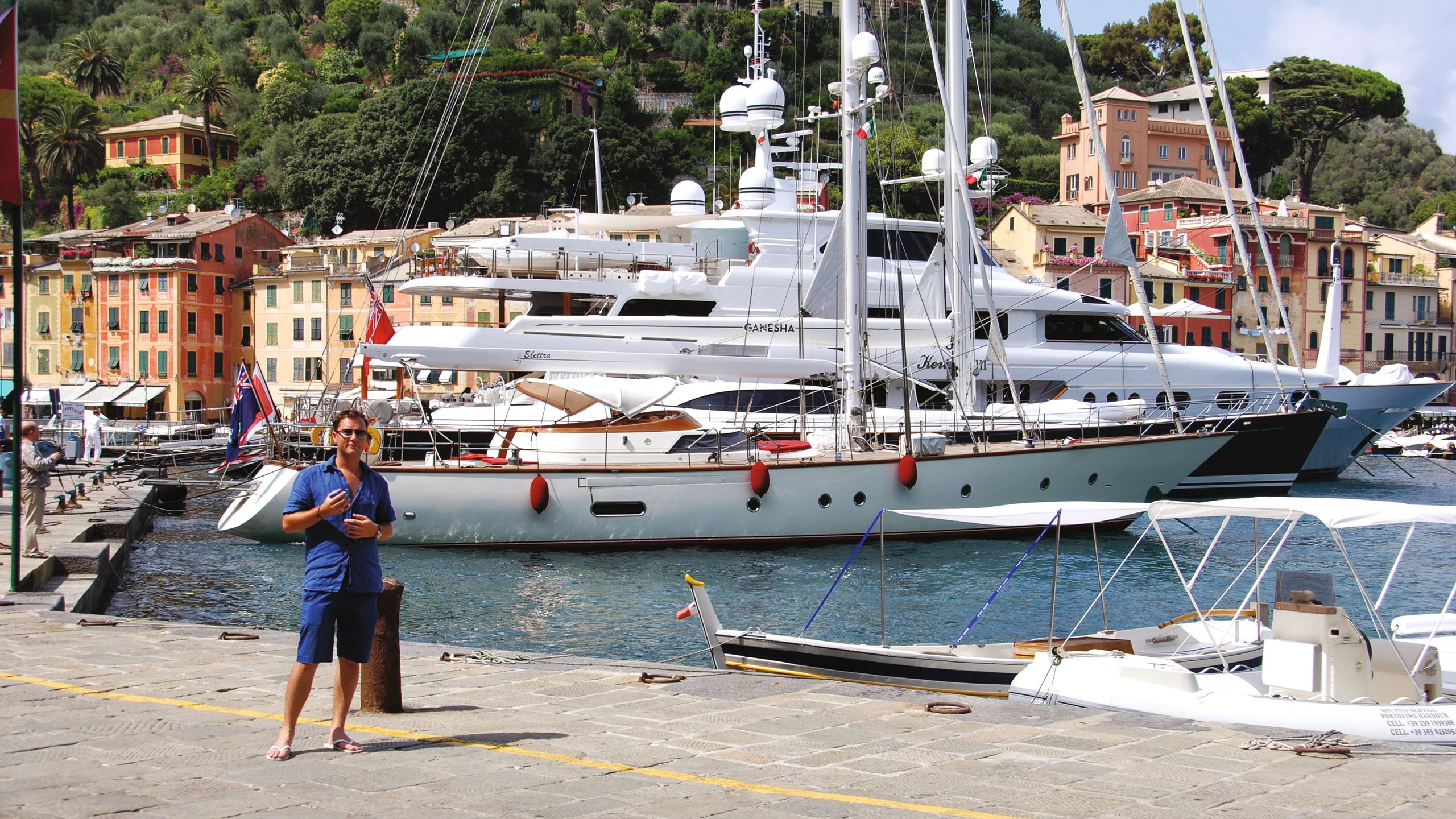
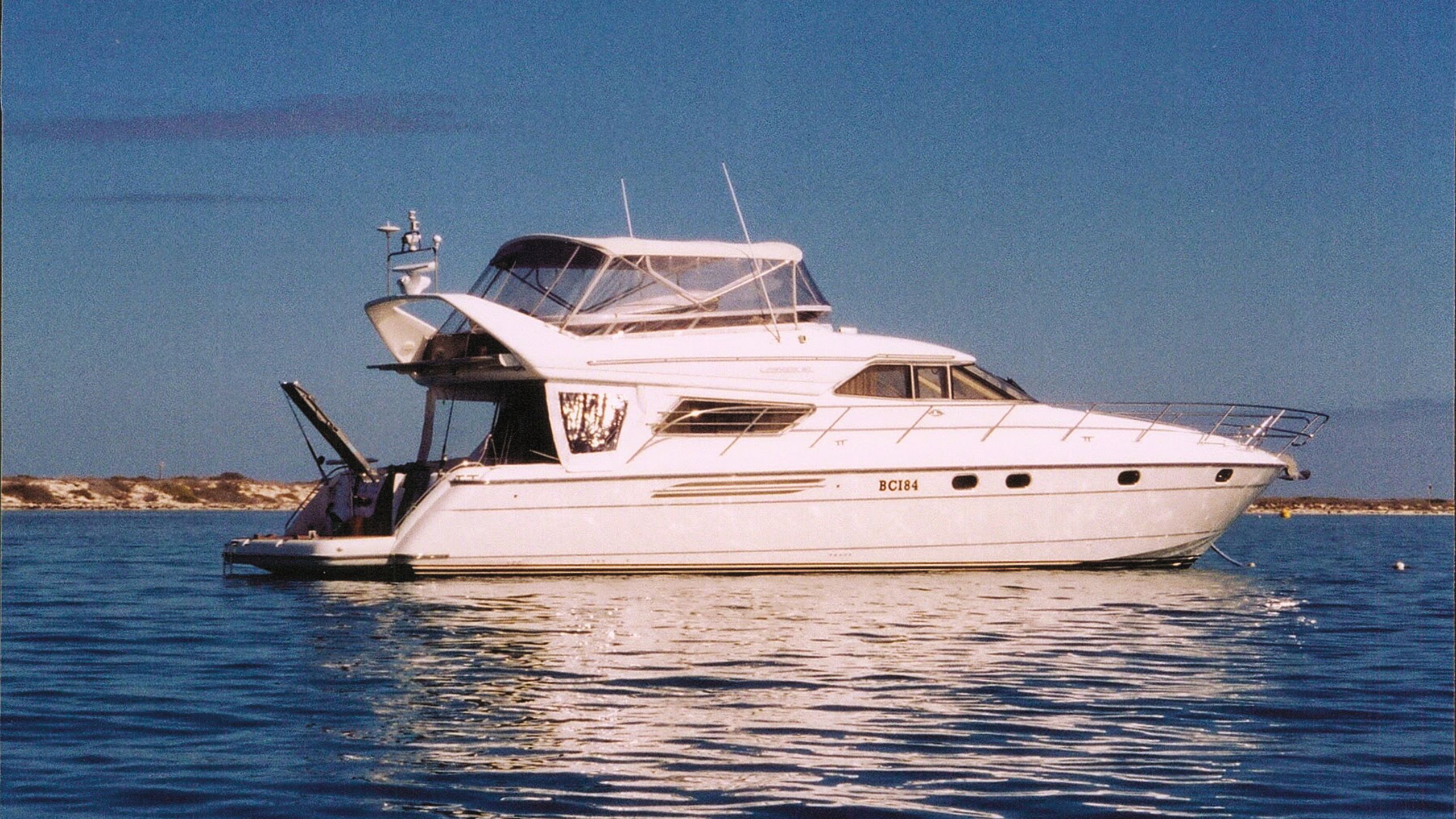
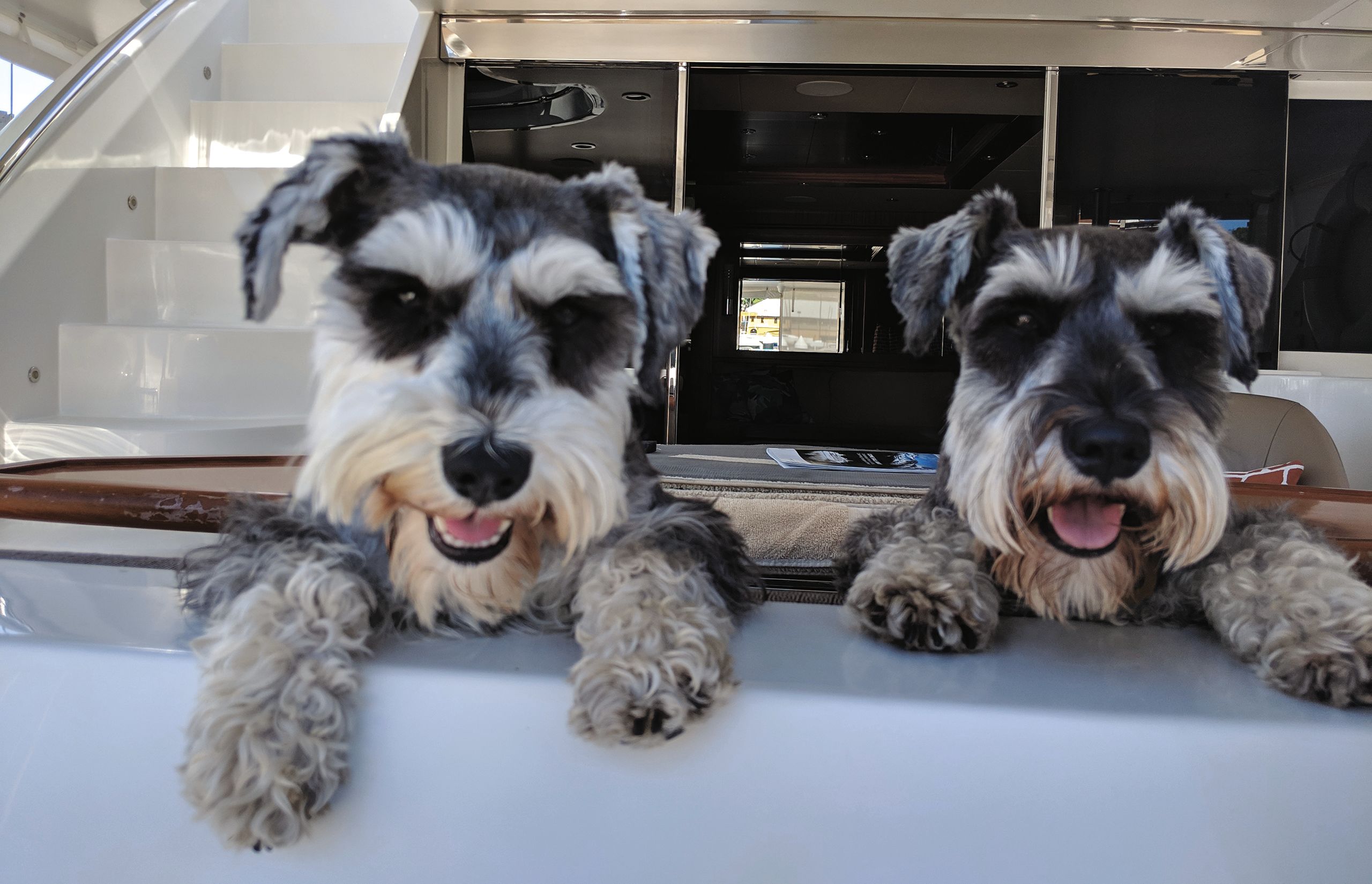
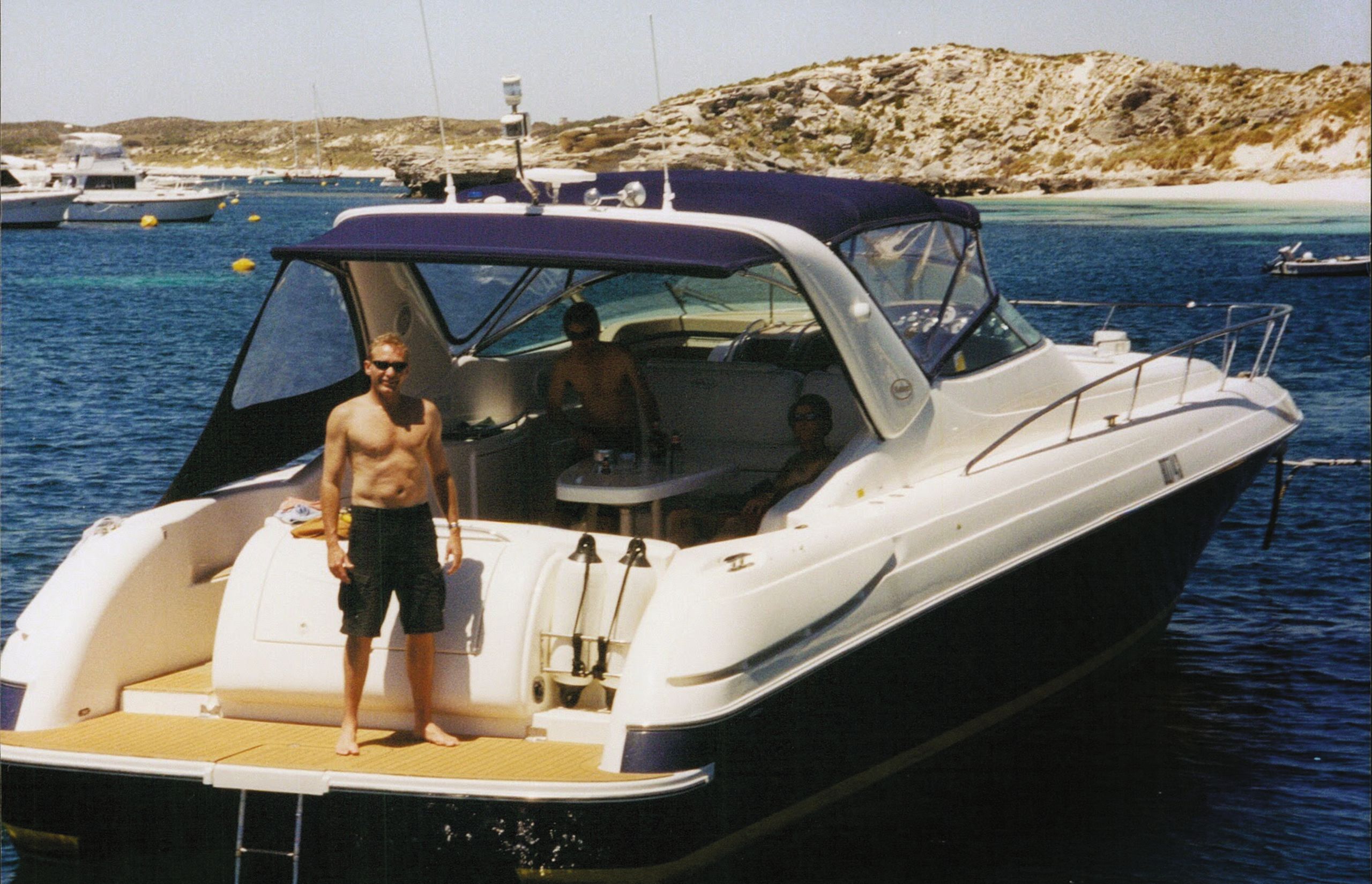

COURTESY OF OWNERS
COURTESY OF OWNERS

COURTESY OF OWNERS
COURTESY OF OWNERS

COURTESY OF OWNERS
COURTESY OF OWNERS

COURTESY OF OWNERS
COURTESY OF OWNERS
Top left: The couple’s 24.1-metre sailing yacht Elettra accompanied them on their Med adventures, but Australia – and their miniature schnauzers Rudi and Heidi (bottom left) – would be better served by a more powerful option.
The two friends tried a series of sales roles: cut flowers, fax machines and, finally, insurance. And this is where something clicked for Watkins. “In 1987, we started building what is today called a general agency. Rather than selling insurance, we started recruiting agents to sell it for us, plugging in leads. We got into new customers buying houses who needed to look at life and home insurance.”
“Horizon went back to the drawing board and came back with a 31-metre. They liked it so much, they’ve used it to launch their biggest-selling boat!”
Recession in the 1990s could have derailed this burgeoning business, as interest rates spiked above 20 per cent, but Watkins and his friend-turned-business-partner performed a neat pivot to stay ahead. “People couldn’t buy houses, so we turned our minds to managing the financing process and affording the house, as well as the lifestyle protection components.”
So, although AFG depends as a business on people being able to go outside and move house, it has weathered economic storms before, and has even come through Covid stronger, according to the balance sheet. Watkins and Kerr, meanwhile, came through the pandemic wanting a new, larger yacht.
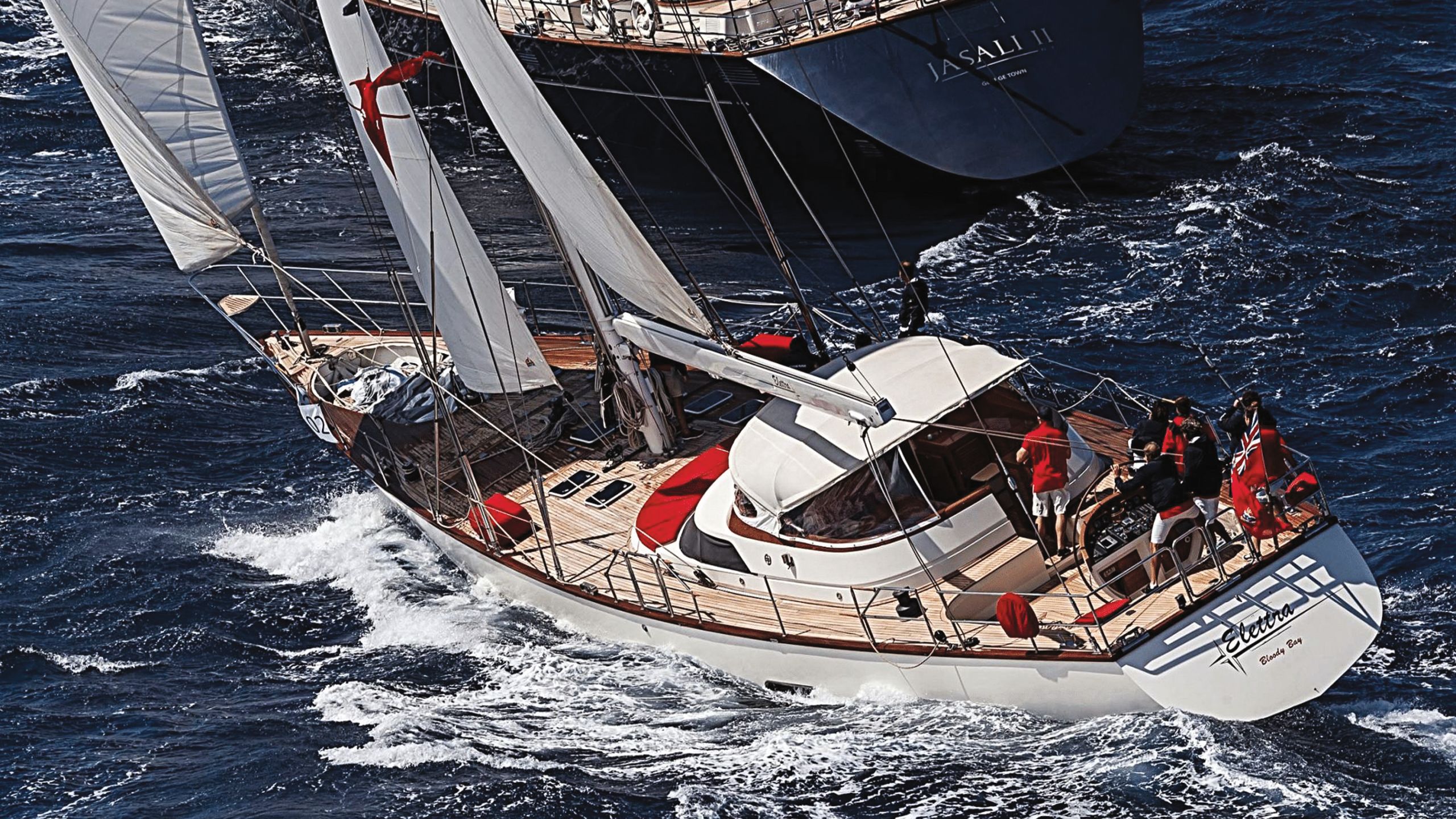
“After four years, we looked at upgrading,” says Watkins. “We knew everything that the Ocean Alexander lacked and everything that we loved about it.”
They went to see a range of semi-production yachts, without finding what they sought. “We looked at a lot of explorer boats, but we wanted luxury with a big range,” says Kerr.
“So, we realised that we needed to go and build our own boat, customise off a standard platform,” finishes Watkins. “It had to have a 2,000 to 3,000-mile range, because if you want to sail to a nearby island here, it’s at least 1,000 miles! We also wanted a boat with plenty of deck area aft and capable of carrying a lot of toys in the garage. That meant a boat with decent length and beam – the volume of a 40-metre. The problem is, once you get over 25 metres, you get into a lot of marina restrictions. In the Whitsundays, the moorings cap out at 30 metres, and at 35 metres, you need a pilot to come into the river systems and ports.”
The couple had already seen something they liked by Horizon Yachts, the booming Taiwanese composite specialist. It had the edgy looks of an explorer with a high, plumb bow and trawler windows, but it only measured 28 metres. The next model up was a 33-metre tri-decker with a spectacular open flybridge. The obvious solution? Something in between.
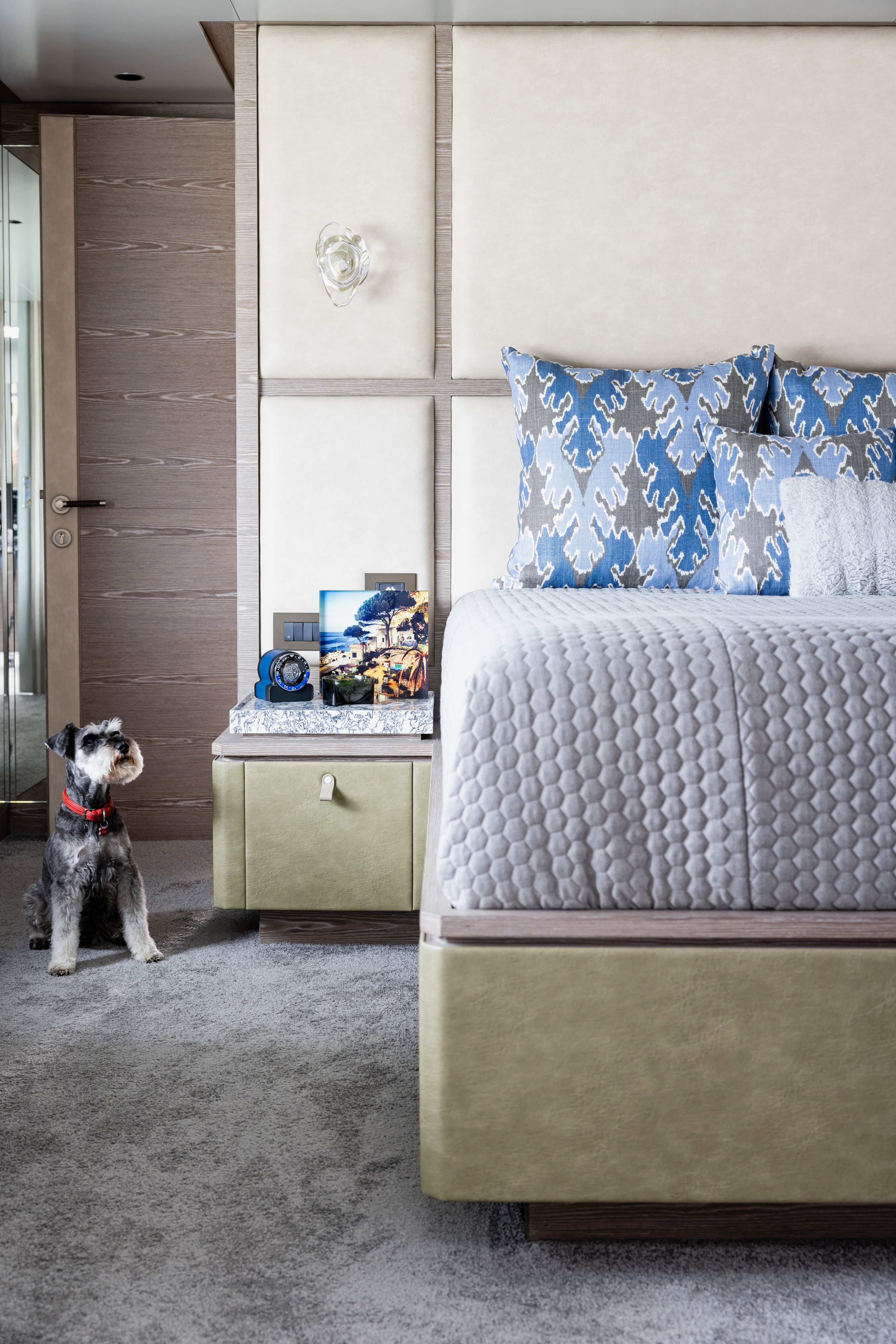
BROCK BEAZLEY
BROCK BEAZLEY
“We realised that we needed to go and build our own boat, customise off a standard platform”
“Horizon went back to the drawing board, spoke to their engineers and came back with a 103-footer (31-metre),” says Watkins triumphantly. “They liked it so much, they’ve used it to launch their biggest-selling model in recent times!” “We went with Horizon because of the level of customisation they gave us,” says Kerr.
But Watkins scoffs at that. “Horizon were so flexible, they created a whole new model to get it the way we wanted!”
“We wanted an entertainer’s kitchen rather than a galley. And because we didn’t want a cook, we didn’t want a boat where one of us was cooking downstairs in a hole”
Kerr explains how smoothly the design and build process went at a time when they couldn’t travel to the Taiwan yard. The requirements were sketched out: tender on the bow to free up the aft deck for the spa and loungers. “Australia is windy compared to the Med, and then if you’re in [a spa on the bow], you’re removed from everyone else who’s in the entertaining space aft,” Watkins says.
The beach club aft includes a beefed-up hydraulic platform, capable of hoisting a Castoldi 15 Diesel Jet Tender well clear of the water. And the toy storage in the transom is copious. Keeping the outdoor focus further up the boat, the flybridge is full beam and the upper saloon has doors that fold away fully to one side.
There was one other thing that the couple wanted, and that initially proved controversial: Kerr wanted to design the interior himself. “I had just finished designing our last home – a dream house in Melbourne, before Covid hit. There was pushback [from Horizon], but after seeing what I’d done in different houses, they accepted it.”
They needn’t have worried, as Kerr has a string of luxury home designs behind him in Melbourne, the Gold Coast and Airlie Beach, and a booming order book. In fact, he notes wryly: “Ocean Alexander just launched one of their latest yachts using the exact same wood and stone combination that I chose for Askari!”
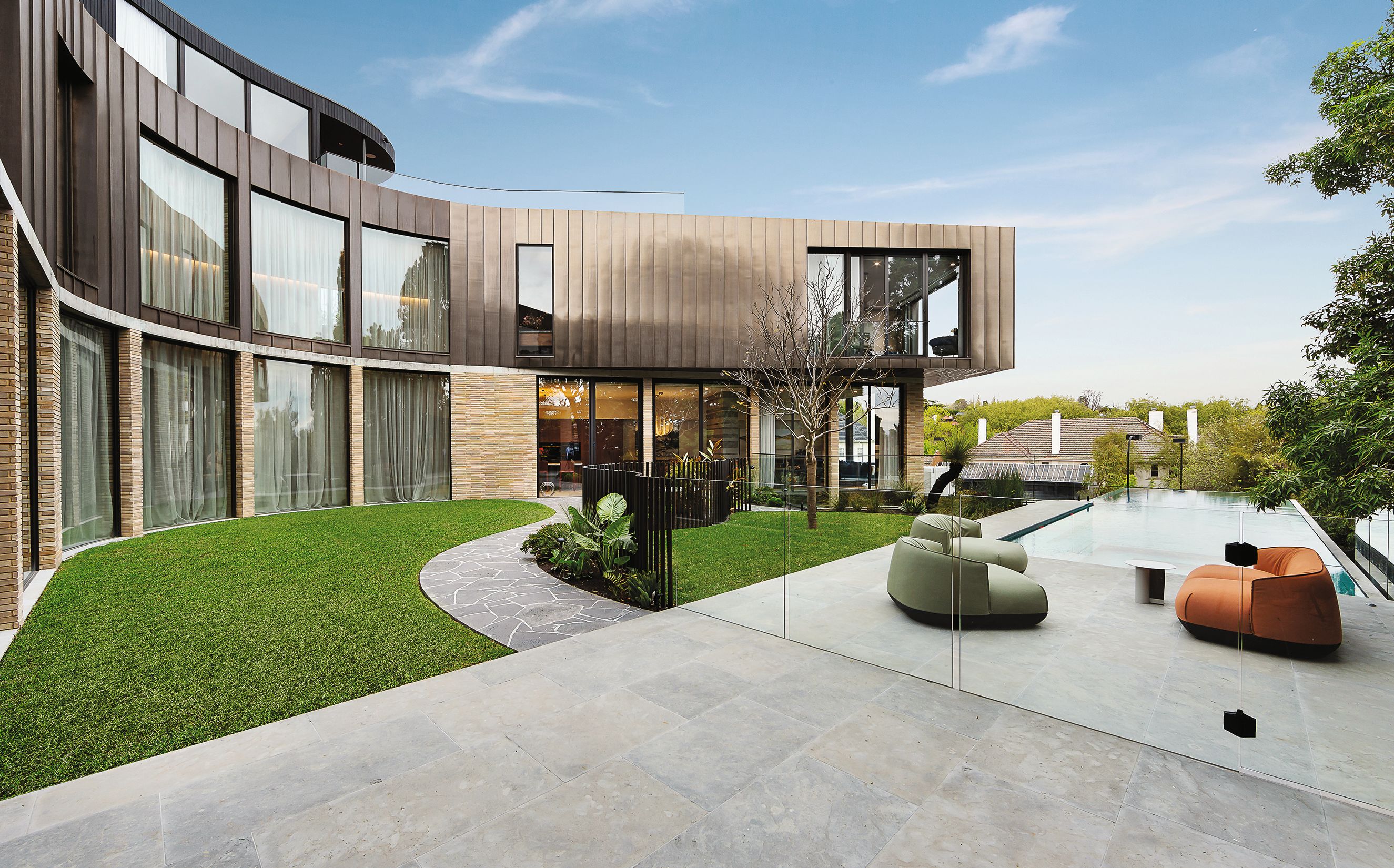
URBAN ANGLES This image and below: the couple’s five bedroom mansion in Melbourne.
URBAN ANGLES This image and below: the couple’s five bedroom mansion in Melbourne.
The result is modern, but relaxed; a beach house where experienced ownership is visible.“I kept the colour neutral because when we’re sailing, there are floor-to-ceiling windows and the sea is the deco,” says Kerr. There are still some surprising touches and bursts of energetic colour. The main saloon has a wool rug with an abstract pattern in navy and sky blues with elements of almost fluorescent lime. Scatter cushions throughout the boat pick up the theme, and there’s a lot of handblown glass in the numerous light fittings. Kerr has also used low-profile Samsung Frame TVs throughout the boat to display changeable art.
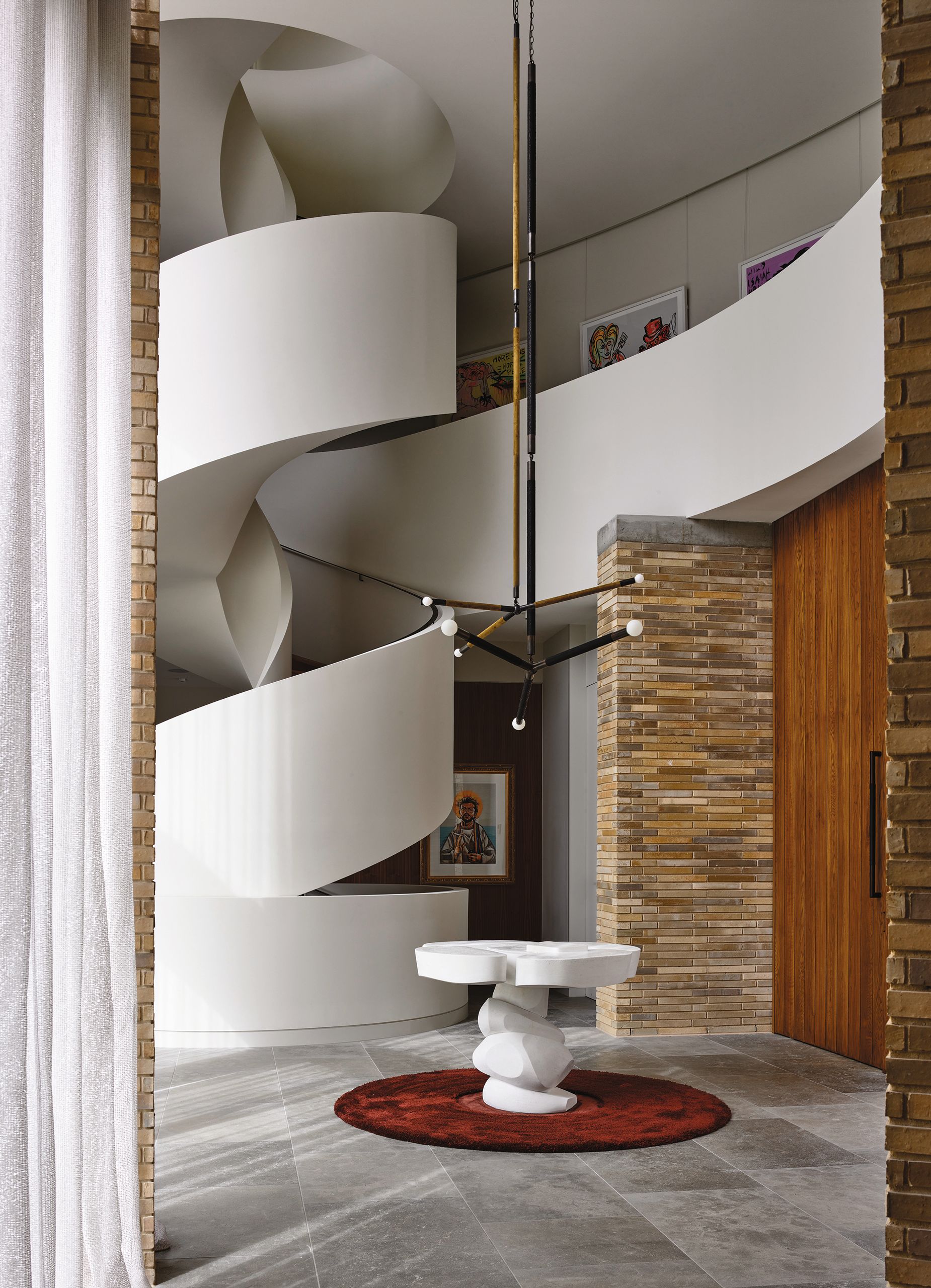
URBAN ANGLES
URBAN ANGLES
“A lot of boats have too much wood, so we found this beautiful linen-look wallpaper for the high-traffic areas, which is actually vinyl, but looks like paper,” Kerr continues. “For the saloon couch, I used indoor-outdoor fabric in a dark colour, so when the dogs are coming off the beach and you don’t catch them quickly enough, it doesn’t show up. We’re not too precious – Askari looks great, but it’s not like you’re living in a dolls house!”
There’s a whimper from one of the dogs, who has been watching the interview from a corner. That’s Rudi, I discover, companion to Heidi. It’s as if they’re agreeing with Kerr, giving their approval to the design of the new boat. With Askari meaning “warrior” in Swahili and the 11-metre chase boat Melinzi evoking a “chaperone”, the dogs and their owners are going to be in very good hands as they criss-cross the Pacific islands.
First published in the July 2023 issue of BOAT International. Get this magazine sent straight to your door, or subscribe and never miss an issue.
PETE KERR'S FIVE ESSENTIAL
RULES FOR DESIGN
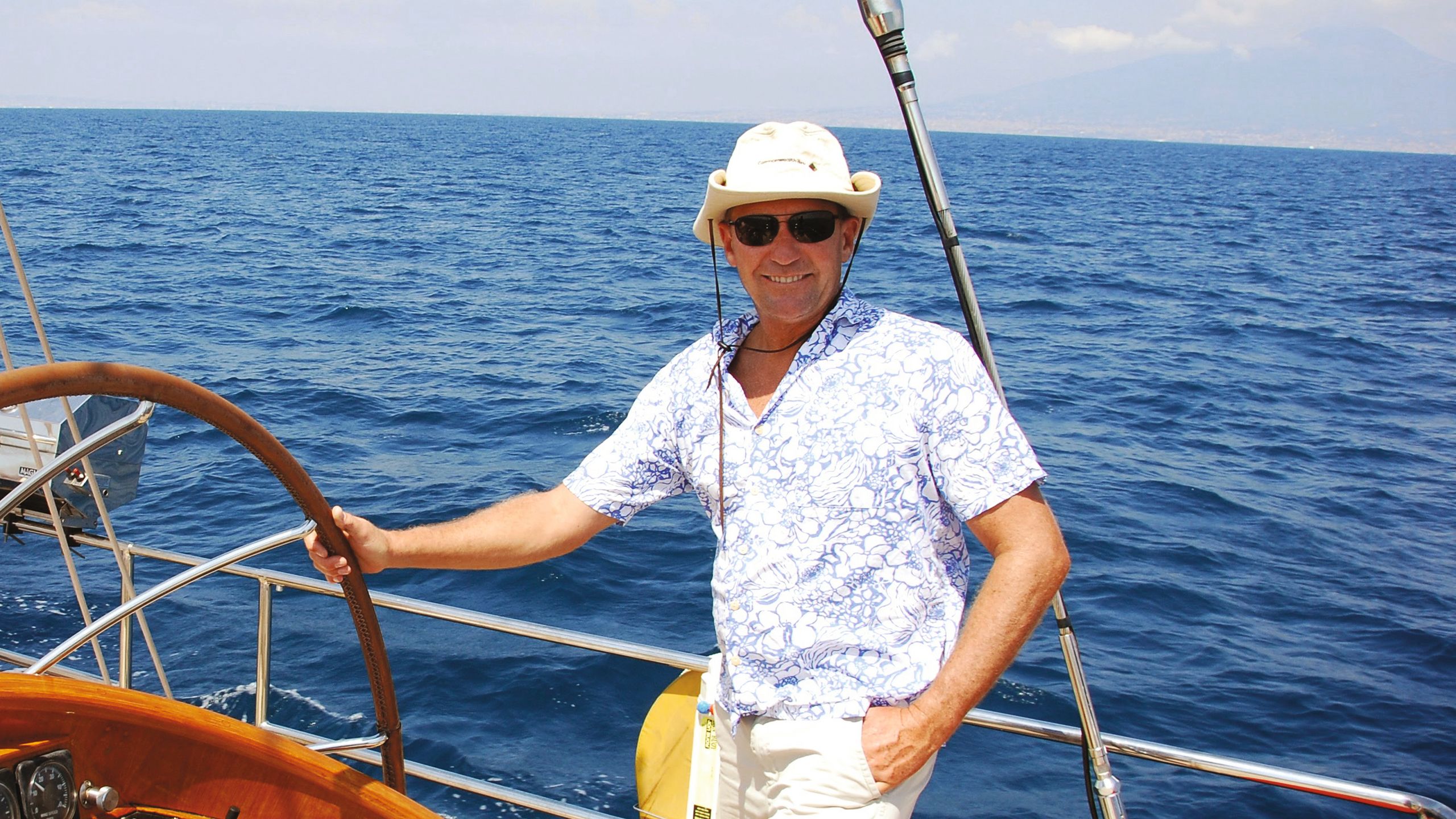
RULE ONE
FUNCTION ALONGSIDE FORM
“Think about functionality and upkeep before falling in love with a finish. Exotic natural stone may be the height of luxury, but it requires a lot of maintenance. High-end quartz surfaces are practically indestructible and look exactly the same, paying dividends if you are away from port for extended periods. I also introduced a linen-look vinyl wallpaper I saw at the St Regis Perth to all high-traffic areas on Askari. Not only did it add texture, but seeing fingerprints is now a thing of the past.”
RULE TWO
WINDOW FURNISHINGS MATTER
“With floor-to-ceiling windows becoming the new standard in boat design, having multiple ways to diffuse light into your boat is key. My favourite combination is luxurious linen sheer curtains with black-out blinds, making your boat feel homely, and adding privacy and protection while in port.”
RULE THREE
KEEP BOLD AND PERSONAL DESIGNS INTERCHANGEABLE
“I’m a big believer in keeping a base palette neutral but textural. From there you can introduce bold feature prints and colour into scatter cushions, soft furnishings and artwork. Frame TVs also work perfectly on boats. These can easily be updated as your tastes or trends evolve, and keep your buyer pool broader when it’s inevitably time to upgrade to your next vessel.”
RULE FOUR
BUILT-IN FURNITURE IS NOT A NECESSITY
“Stabiliser technology has advanced to a point that only the largest seas will really rock you, so the need to integrate furniture has receded. This paves the way for you to include statement furniture from your favourite design houses.”
RULE FIVE
FIND THE RIGHT DESIGNER FOR YOU
“Find a designer that will truly bring your vision to reality by stalking them (not literally, of course…). Pinterest and Instagram are filled with visually stunning interiors that can be used for inspiration mood boards and act as an additional resumé for anyone you are thinking about working with.” plkdesign.com.au; Instagram: @plkdesign
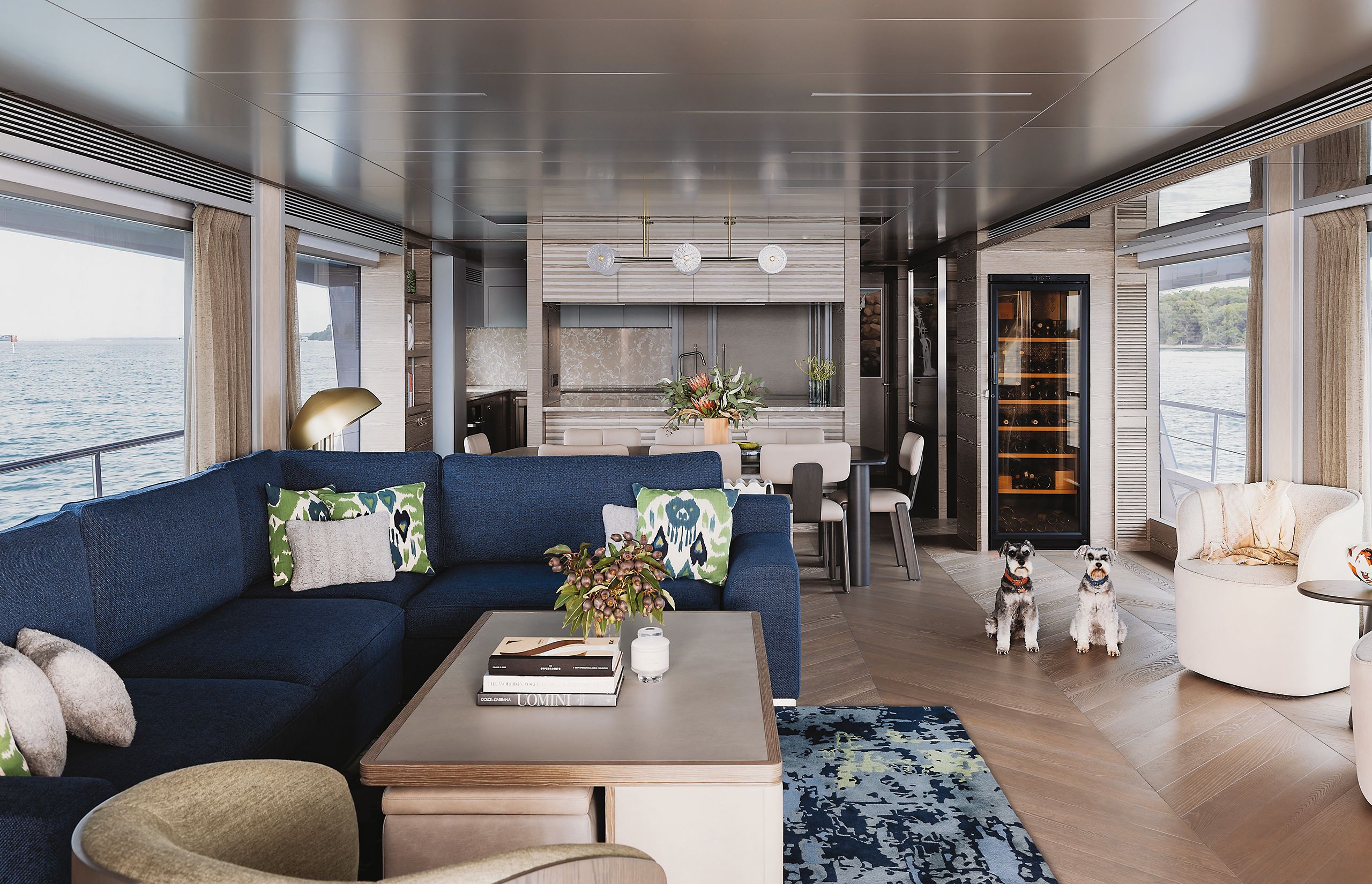
BROCK BEAZLEY
BROCK BEAZLEY

